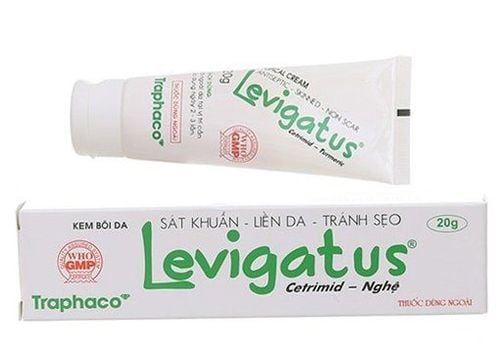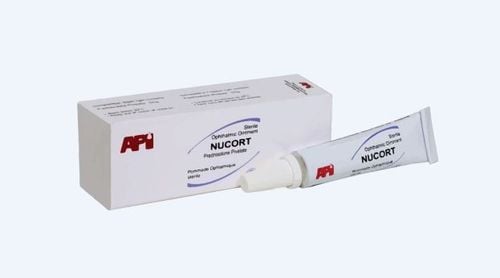This is an automatically translated article.
Tratrison topical is used to treat skin problems such as dermatitis, skin allergies, diaper rash,... The main ingredients of the drug include Betamethasone, Clotrimazole, Gentamicin. Tratrison drug can be used for all subjects and all ages, but pregnant women should consult a doctor before deciding to use the drug.
1. What is Tratrison?
Tratrison drug is used for topical application, has the effect of treating skin problems such as dermatitis, skin allergies, diaper rash, ... The main ingredients of the drug include Betamethasone 6.4mg, Clotrimazole 100mg, Gentamicin 100mg and excipients just enough 1 tablet. Tratrison is a prescription drug, so you should only use it when prescribed by your doctor. Packaging of the drug includes a box of 1 tube with a weight of 10g.
2. What effect does Tratrison have when used?
The effect of the drug Tratrison is based on the main components of the drug:
Betamethasone: has strong activity, is essentially a synthetic corticosteroid. This active ingredient has anti-inflammatory, anti-rheumatic and allergic reactions. Clotrimazole: Belongs to the imidazole group with broad antibacterial spectrum. Clotrimazole is a synthetic antifungal drug. The mechanism of action of this substance is to bind to phospholipids at the fungal cell membrane, where they alter membrane permeability and destroy fungal cells. Gentamicin: This active ingredient has the ability to attach to 30S subunits, changing the sequence of both DNA in bacteria, so that the drug can kill bacteria. Gentamicin is active against gram-negative aerobic bacteria, gram-positive bacteria (staphylococci, pneumococci, streptococci).
3. In which groups should Tratrison be prescribed?
Indications to use Tratrison drug in the following cases:
Allergic and inflammatory skin cases: Acute and chronic eczema, diaper rash, contact dermatitis, neurodermatitis, exfoliative dermatitis, inflammation seborrheic skin, minor burns, psoriasis, ... Itching due to insect bites Itching in the vulva and anal area Ringworm: ringworm, ringworm, foot water, nail fungus, hair loss due to fungus,. .
4. Instructions for using Tratrison and drug dosage
Tratrison is used for topical application, patients should apply 2 times a day (morning, evening). Take an appropriate amount of the medicine and gently apply it to the infected skin. For the best treatment results, patients should use the drug regularly and regularly. In case of using the drug for 3-4 weeks but the condition does not improve or becomes worse, you should consult your doctor to change the dose or use other more effective measures.
During the use of the drug, you should follow the instructions of your doctor. Never exceed the prescribed dose to avoid possible side effects.
5. What to do in case of an overdose of Tratrison?
Overdose is the case where the patient uses more than the prescribed amount of medicine. As for Tratrison, so far no overdose cases have been recorded. In case the patient has symptoms of poisoning, the patient should be transported to a medical center to get help from medical staff.
If you miss a dose of Tratrison, you should take it as soon as you remember. During treatment with the drug should minimize missed doses.
6. Unwanted side effects may occur during the use of Tratrison
While using Tratrison, the patient may appear some symptoms such as:
Erythema Leakage, itching of the infected skin, heat Decreased red blood cells Systemic allergies Urticaria Urticaria Fish scale disease When taking the drug over a large area of skin and using a compression bandage: Causes dryness, skin irritation, folliculitis, hair growth, hypopigmentation, appearance of millet, skin lines, skin atrophy,... If Patients with one of the above symptoms should stop using Tratrison and immediately notify the treating doctor for appropriate management measures.
7. Tratrison should not be used with which groups of subjects?
Absolutely not indicated for patients to use the drug if there are the following factors:
People are sensitive to the ingredients in Tratrison . The area of the skin that needs to be used has an open wound or exudes mucus.
8. Possible drug interactions with Tratrison
During the use of Tratrison may occur interactions with drugs or functional products, food. Therefore, before using the drug, you should provide your doctor with a list of drugs, functional products, and foods that you are taking. From there, the doctor can give you advice and notes when treating to avoid possible unfortunate consequences.
9. Some notes when using Tratrison and instructions on drug preservation
Currently, there are no studies to prove the safety of Tratrison for people who are pregnant and breastfeeding, so before taking the drug you should discuss carefully with your doctor about the benefits and side effects of the drug. Do not use the medicine on large areas of skin, pressure bandages, open wounds or injuries. Do not use the drug in patients with cross-allergic aminoglycosides. Do not use the medicine for a long time and keep the wound covered. Caution should be exercised when administering Tratrison to young children. How to store Tratrison
Patients should store Tratrison in a cool and dry place. The appropriate temperature for storage and preservation is lower than 30 degrees Celsius. If the medicine shows signs of deterioration, changes in color, has a strange smell, it should be discontinued immediately. Do not leave Tratrison in a place with high air humidity and avoid direct sunlight.
Tratrison drug is used to treat skin problems such as dermatitis, skin allergies, diaper rash, ... The drug is widely used due to its high therapeutic effect, safety and low cost. However, if you do not use Tratrison properly, it can cause unwanted side effects, so you should discuss it carefully with your doctor before deciding to use the drug.
Follow Vinmec International General Hospital website to get more health, nutrition and beauty information to protect the health of yourself and your loved ones in your family.













